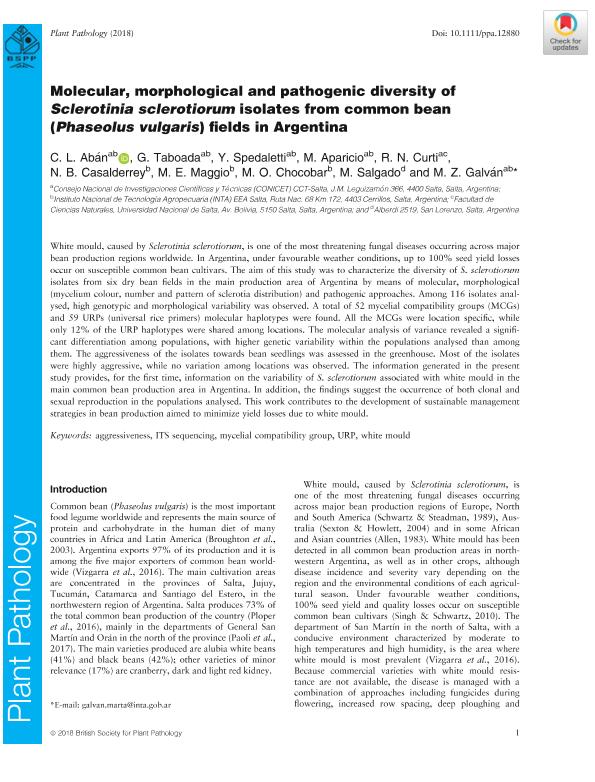Mostrar el registro sencillo del ítem
dc.contributor.author
Aban, Carla Luciana

dc.contributor.author
Taboada, Gisel María

dc.contributor.author
Spedaletti, Yamila Andrea

dc.contributor.author
Aparicio, M.
dc.contributor.author
Curti, Ramiro Nestor

dc.contributor.author
Casalderrey, Norma Beatriz

dc.contributor.author
Maggio, María Elisa

dc.contributor.author
Chocobar, M. O.
dc.contributor.author
Salgado, M.
dc.contributor.author
Galván, Marta Zulema

dc.date.available
2019-12-05T17:46:01Z
dc.date.issued
2018-10
dc.identifier.citation
Aban, Carla Luciana; Taboada, Gisel María; Spedaletti, Yamila Andrea; Aparicio, M.; Curti, Ramiro Nestor; et al.; Molecular, morphological and pathogenic diversity of Sclerotinia sclerotiorum isolates from common bean (Phaseolus vulgaris) fields in Argentina; Wiley Blackwell Publishing, Inc; Plant Pathology; 67; 8; 10-2018; 1740-1748
dc.identifier.issn
0032-0862
dc.identifier.uri
http://hdl.handle.net/11336/91501
dc.description.abstract
White mould, caused by Sclerotinia sclerotiorum, is one of the most threatening fungal diseases occurring across major bean production regions worldwide. In Argentina, under favourable weather conditions, up to 100% seed yield losses occur on susceptible common bean cultivars. The aim of this study was to characterize the diversity of S. sclerotiorum isolates from six dry bean fields in the main production area of Argentina by means of molecular, morphological (mycelium colour, number and pattern of sclerotia distribution) and pathogenic approaches. Among 116 isolates analysed, high genotypic and morphological variability was observed. A total of 52 mycelial compatibility groups (MCGs) and 59 URPs (universal rice primers) molecular haplotypes were found. All the MCGs were location specific, while only 12% of the URP haplotypes were shared among locations. The molecular analysis of variance revealed a significant differentiation among populations, with higher genetic variability within the populations analysed than among them. The aggressiveness of the isolates towards bean seedlings was assessed in the greenhouse. Most of the isolates were highly aggressive, while no variation among locations was observed. The information generated in the present study provides, for the first time, information on the variability of S. sclerotiorum associated with white mould in the main common bean production area in Argentina. In addition, the findings suggest the occurrence of both clonal and sexual reproduction in the populations analysed. This work contributes to the development of sustainable management strategies in bean production aimed to minimize yield losses due to white mould.
dc.format
application/pdf
dc.language.iso
eng
dc.publisher
Wiley Blackwell Publishing, Inc

dc.rights
info:eu-repo/semantics/openAccess
dc.rights.uri
https://creativecommons.org/licenses/by-nc-sa/2.5/ar/
dc.subject
AGGRESSIVENESS
dc.subject
ITS SEQUENCING
dc.subject
MYCELIAL COMPATIBILITY GROUP
dc.subject
URP
dc.subject
WHITE MOULD
dc.subject.classification
Agricultura

dc.subject.classification
Agricultura, Silvicultura y Pesca

dc.subject.classification
CIENCIAS AGRÍCOLAS

dc.title
Molecular, morphological and pathogenic diversity of Sclerotinia sclerotiorum isolates from common bean (Phaseolus vulgaris) fields in Argentina
dc.type
info:eu-repo/semantics/article
dc.type
info:ar-repo/semantics/artículo
dc.type
info:eu-repo/semantics/publishedVersion
dc.date.updated
2019-10-23T21:35:39Z
dc.journal.volume
67
dc.journal.number
8
dc.journal.pagination
1740-1748
dc.journal.pais
Reino Unido

dc.journal.ciudad
Londres
dc.description.fil
Fil: Aban, Carla Luciana. Instituto Nacional de Tecnología Agropecuaria. Centro Regional Salta-Jujuy. Estación Experimental Agropecuaria Salta; Argentina. Consejo Nacional de Investigaciones Científicas y Técnicas; Argentina
dc.description.fil
Fil: Taboada, Gisel María. Instituto Nacional de Tecnología Agropecuaria. Centro Regional Salta-Jujuy. Estación Experimental Agropecuaria Salta; Argentina. Consejo Nacional de Investigaciones Científicas y Técnicas; Argentina
dc.description.fil
Fil: Spedaletti, Yamila Andrea. Instituto Nacional de Tecnología Agropecuaria. Centro Regional Salta-Jujuy. Estación Experimental Agropecuaria Salta; Argentina. Consejo Nacional de Investigaciones Científicas y Técnicas; Argentina
dc.description.fil
Fil: Aparicio, M.. Instituto Nacional de Tecnología Agropecuaria. Centro Regional Salta-Jujuy. Estación Experimental Agropecuaria Salta; Argentina. Consejo Nacional de Investigaciones Científicas y Técnicas; Argentina
dc.description.fil
Fil: Curti, Ramiro Nestor. Universidad Nacional de Salta. Facultad de Ciencias Naturales. Escuela de Agronomía. Laboratorio de Investigaciones Botánicas; Argentina. Consejo Nacional de Investigaciones Científicas y Técnicas; Argentina
dc.description.fil
Fil: Casalderrey, Norma Beatriz. Instituto Nacional de Tecnología Agropecuaria. Centro Regional Salta-Jujuy. Estación Experimental Agropecuaria Salta; Argentina
dc.description.fil
Fil: Maggio, María Elisa. Instituto Nacional de Tecnología Agropecuaria. Centro Regional Salta-Jujuy. Estación Experimental Agropecuaria Salta; Argentina
dc.description.fil
Fil: Chocobar, M. O.. Instituto Nacional de Tecnología Agropecuaria. Centro Regional Salta-Jujuy. Estación Experimental Agropecuaria Salta; Argentina
dc.description.fil
Fil: Salgado, M.. Instituto Nacional de Tecnología Agropecuaria. Centro Regional Salta-Jujuy. Estación Experimental Agropecuaria Salta; Argentina
dc.description.fil
Fil: Galván, Marta Zulema. Instituto Nacional de Tecnología Agropecuaria. Centro Regional Salta-Jujuy. Estación Experimental Agropecuaria Salta; Argentina. Consejo Nacional de Investigaciones Científicas y Técnicas; Argentina
dc.journal.title
Plant Pathology

dc.relation.alternativeid
info:eu-repo/semantics/altIdentifier/url/https://bsppjournals.onlinelibrary.wiley.com/doi/abs/10.1111/ppa.12880
dc.relation.alternativeid
info:eu-repo/semantics/altIdentifier/doi/http://dx.doi.org/10.1111/ppa.12880
Archivos asociados
